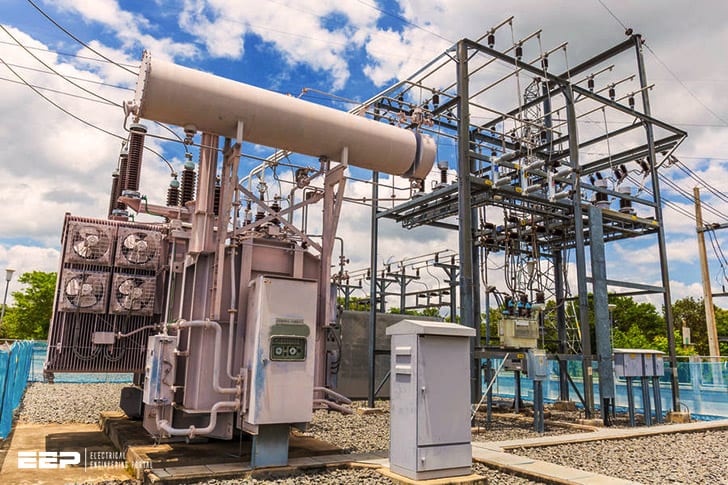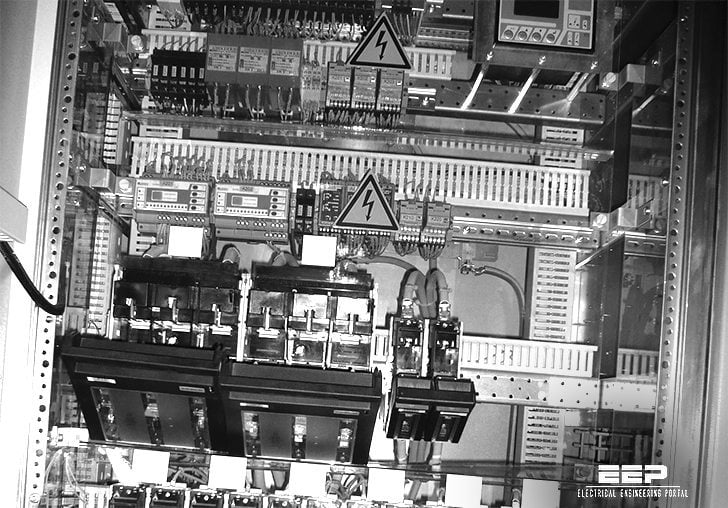A circuit breaker is a device that interrupts the flow of electricity in an electrical circuit. It is used to protect equipment and people from damage caused by excess current. Circuit breakers are found in electrical panels, industrial equipment, and automobiles.
Substations: Basic Principles | Circuit Breakers | Disconnectors | Relays | CTs & VTs | Arresters
A circuit breaker is a device that is used to open or close an electrical circuit. Circuit breakers are used in substations to protect the equipment from damage due to overcurrents. When an overcurrent occurs, the circuit breaker trips and opens the circuit, preventing the flow of current and protecting the equipment.
Types of Circuit Breaker in Substation
There are many different types of circuit breakers used in substations. The type of circuit breaker used depends on the voltage and current rating of the substation, as well as the equipment that is being protected. The most common types of circuit breakers used in substations are air-break, oil-filled, and vacuum.
Air-break circuit breakers use compressed air to extinguish the arc when the breaker is opened. These types of breakers are typically used for voltages up to 38 kV. Oil-filled circuit breakers use oil to cool and extinguish the arc.
These types of breakers are typically used for voltages up to 345 kV. Vacuum circuit breakers use a vacuum chamber to extinguish the arc. These types of breakers are typically used for voltages above 345 kV.
Use of Circuit Breaker in Substation
Use of Circuit Breaker in Substation
A circuit breaker is a device that breaks an electrical circuit, interrupting the flow of current. It is used to protect equipment from damage caused by overcurrent or short-circuiting.
Circuit breakers are essential components of electrical power distribution systems. They are used in substations to switch high-voltage circuits, and in distribution networks to switch low-voltage circuits. Circuit breakers can be either manually operated or automatically operated.
Automatic operation is achieved using sensors that detect an overcurrent or short-circuit condition and activate the breaker.
Manually operated circuit breakers are used for maintenance purposes, such as when replacing a fuse or troubleshooting a circuit. Automatically operated circuit breakers are usually found in industrial and commercial applications where they provide protection against faults on the electrical system.
When an overcurrent or short-circuit occurs, the circuit breaker trips, opening its contacts and interrupting the flow of current. The contacts must be able to open and close quickly enough so that the arc created by the fault does not cause excessive heating that could damage the equipment.
The use of circuit breakers in substations provides many benefits, including:
• improved reliability – by reducing the number of outages caused by faults;
• increased safety – by providing isolation between live parts;
• reduced maintenance costs – by eliminating the need to replace fuses; and
Gas Circuit Breaker in Substation
A gas circuit breaker is a type of electrical switch that uses compressed gas to extinguish an arc during operation. This type of breaker is often used in high-voltage applications, such as substations, where it can interrupt large currents.
Gas circuit breakers have several advantages over other types of breakers.
For example, they are less likely to be damaged by electrical surges and can be operated more rapidly than other types of breakers. Additionally, gas circuit breakers can be designed to automatically re-close after an interruption, which helps to reduce downtime in the event of a power outage.
Oil Circuit Breaker in Substation
An oil circuit breaker is a type of electrical circuit breaker that uses oil as an insulating medium. Oil circuit breakers are used in high-voltage power distribution systems for the protection of transformers, generators, and other equipment.
The first oil circuit breakers were developed in the early 1900s and were used extensively in power plants and substations throughout the 20th century.
However, due to their large size and heavy weight, oil circuit breakers have been largely replaced by air-blast and SF6 gas-insulated breakers in new installations.
Despite this, oil circuit breakers continue to be used in many existing power plants and substations due to their reliability and longevity. In fact, some oil circuit breakers have been in service for over 50 years!
If you’re looking for an expert team to help maintain your oil circuit breaker, look no further than Circuit Breaker Service Company. Our team has over 35 years of experience servicing all types of electrical equipment, including oil circuit breakers. Contact us today for more information!
Relays in Substation
A substation is a critical part of the electrical grid, and relays play an important role in its operation. Relays are used to protect equipment and personnel from damage or injury by automatically opening or closing circuits in response to changes in conditions.
Substations typically have a high voltage side and a low voltage side.
The high voltage side is where electricity comes into the substation, and the low voltage side is where it goes out to customers. In between these two sides are transformers that step down the voltages so that they can be safely handled by the lower voltage equipment.
Relays are placed throughout the substation, both on the high and low voltage sides, in order to monitor conditions and respond accordingly.
For example, if there is a sudden increase in current on the high voltage side, a relay will open the circuit to prevent damage to equipment. Or if there is a loss of power on the low voltage side, a relay will close the circuit to provide backup power from generators.
Relays are essential for safe and reliable operation of substations, and they must be carefully selected and maintained to ensure proper function.
Substation Circuit Breakers Can Be Operated by ? Or ? Controls.
Substation circuit breakers can be operated by either local or remote controls. Local controls are typically used when the breaker is located within easy reach of the operator, while remote controls are used when the breaker is located in a difficult-to-reach location.
High Voltage Circuit Breaker Pdf
A circuit breaker is an automatically operated electrical switch designed to protect an electrical circuit from damage caused by overload or short circuit. Its basic function is to interrupt current flow after a fault is detected. Unlike a fuse, which operates once and then must be replaced, a circuit breaker can be reset (either manually or automatically) to resume normal operation.
The three common types of circuit breakers are low-voltage (LV), medium-voltage (MV), and high-voltage (HV). Low-voltage and medium-voltage breakers are used in residential and commercial applications, while high-voltage breakers are used in electric power plants, substations, and transmission networks.
Circuit breakers are manufactured according to international standards such as IEC 60947.
The most common sizes for LV breakers used in domestic applications are 1–63 A for single phase circuits and 1–80 A for three phase circuits. For MV applications the most common size range is 630 A to 40 kA. HV breakers have much higher ratings ranging up to 765 kV and 4000 A.
The first type of modern airbreak circuit breaker was developed by Clevite Corporation in 1901 and patented in 1903.[1] This design became known as the “Clevite knife blade” design because of its distinctive shape.
Substation Transformer
A substation transformer is a type of power transformer that is used to step down the voltage in an electrical power system. The primary purpose of a substation transformer is to provide a safe, efficient way to distribute electricity from the high-voltage transmission system to the lower-voltage distribution system.
Substation transformers are also used to convert alternating current (AC) to direct current (DC), or vice versa.
In some cases, multiple substation transformers may be needed to serve a single load. For example, if a customer needs three-phase power, three single-phase transformers may be used instead of one larger three-phase transformer.
There are two main types of substation transformers: dry-type and oil-filled.
Dry-type transformers are usually more expensive than oil-filled transformers, but they require less maintenance and have a longer lifespan. Oil-filledtransformers are typically used in outdoor applications because they can withstand harsh weather conditions.
To select the right type of substation transformer for your application, it’s important to consider factors such as operating temperature, noise level, efficiency, life expectancy, and cost.

Credit: new.siemens.com
Which Circuit Breaker is Used in Substation?
A circuit breaker is a device that interrupt the flow of electricity in an electrical circuit. Circuit breakers are used in substations to protect equipment and people from damage when there is an electrical fault. There are many different types of circuit breakers, but the most common type used in substations is the air-break circuit breaker.
Air-break circuit breakers use compressed air to extinguish the arc that forms when the breaker interrupts the electrical current.
How Many Circuit Breakers are Used in Substation?
The number of circuit breakers used in a substation depends on the amount of power that needs to be distributed. A typical substation might have two or three breakers, but larger substations can have up to dozens of breakers. The largest substations can even have hundreds of circuit breakers.
Which Circuit Breaker is Used in 400 Kv Substation?
A 400 kV circuit breaker is an electrical device that is used to break down or disconnect the flow of electricity in a substation. This type of circuit breaker is designed to work with high-voltage systems, such as those found in power plants and other large facilities. When the circuit breaker is triggered, it will open up the connection between the two conductors, stopping the flow of electricity.
What is the Use of Circuit Breaker And Isolator in Substation?
A circuit breaker is an automatically operated electrical switch designed to protect an electrical circuit from damage caused by overload or short circuit. Its basic function is to detect a fault condition and, by interrupting continuity, to immediately discontinue electrical flow. Unlike a fuse, which operates once and then must be replaced, a circuit breaker can be reset (either manually or automatically) to resume normal operation.
An isolator is used for the complete isolation of a part of an electrical installation from the supply voltage when it may need to be worked on or when maintenance needs to take place. It allows safe access for electricians while preventing the possibility of anyone coming into contact with live parts.
Conclusion
A circuit breaker is a device that helps protect an electrical system from damage by interrupting the flow of current. Circuit breakers are used in many different applications, but they are especially important in substations.
Substations are places where electricity is transformed from one voltage to another.
They play a vital role in the electric grid, and circuit breakers help to keep them safe. When there is an overload or fault in the system, circuit breakers open to prevent damage.
Circuit breakers come in many different sizes and types.
The size of the breaker depends on the amount of current that it can handle. There are also two main types of circuit breaker: air-break and oil-immersed. Air-break breakers use air to insulate the contacts, while oil-immersed breakers use oil for insulation.
Circuit breakers are an essential part of any electrical system, but they are especially important in substations. By interrupting the flow of current, they help to prevent damage to the system.



